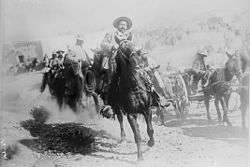Francisco Villa Museum

The Francisco Villa Museum is dedicated to the life and times of Mexican Revolutionary Francisco "Pancho" Villa. This museum is in Chihuahua, Chihuahua, Mexico. Villa was taking a fairly standard visit to Parral on July 20, 1923. However, he usually went accompanied by a number of bodyguards, and this time he went with only four associates. On his drive home, in a 1919 Dodge roadster that can be viewed at the Historical Museum of the Mexican Revolution, someone shouted out "Viva Villa!" After that, seven riflemen appeared and fired more than forty bullets into the car. Nine bullets hit Villa; four went into his head. He died immediately. His body was found with his hand reaching for his gun.
History
The house that is now known as the museum of Francisco "Pancho" Villa was constructed between 1905 and 1907. It is in Chihuahua, Mexico on 3010, Colonia Santa Rosa. By 1911 the house did not fulfill his needs. When Villa was governor of Chihuahua in early 1914, he began to remodel and enlarge the area making it a residence known as "Quinta Luz" in honor of his wife, Señora doña Luz Corral.
The works of the remodeled house was made possible by Santo Vega, Hilario Berumen, Manuel Portillio and Italian painter Mario Ferrer. It was remodeled into three sections: the main house where Villa stayed, the back house, and the courtyard.
By 1915 the house became abandoned because the family took refuge in the United States. After five years, Villa's wife returned because she missed her homeland. Near the end of her life, Luz received visitors from bed, too weak to rise. She died at age 89 on July 6, 1981. Her husband died in 1923 when he Centaurio del Norte was assassinated in Parral, Mexico.
In 1981, Luz Corral, who was ill and too advanced in age to maintain the house, made an offer that when she died the house would be donated to the city provided that they turned it into a museum in honor of Villa. The Ministry of Defense accepted the offer. Because of the poor state in which it was received many restorations had to be made by the National Institute of Anthropology and History.
The house re-opened on November 17, 1982 under the name of the Historical Museum of the Revolution. The office and music room were used to display the personal belongings of Villa. There are photographs and other personal belongings of Villa's era. One exhibit is the car he was traveling in with his escort on the day he was assassinated.
Exhibits
On the first floor of the museum are utensils and furniture that were commonly used by the Villa Corral family.
On the second floor are five showrooms and the Hall of Arms where weapons Francisco Villa used in many combat missions while part of the Northern Division. Some the weapons that are displayed are revolvers, rifles, machine guns, cavalry sabers, baskets and leather cases with brass. There is a photograph of Rafael Mendoza, a native of Maderas, Chihuahua, who during the Mexican Revolution invented the first machine gun air cooled 250 rounds per minute.
In one of the showcases known as the Tragic Room people are able to witness the death of General Villa. In the showcase there is a display that shows the map of the route Villa took before his assassination; also on display are photographs and his death mask, taken three hours after his death.
Gallery

 Gen. Francisco Villa and Luz Corral, 1914.
Gen. Francisco Villa and Luz Corral, 1914. Villa's bedroom. Note pistol hanging from headboard.
Villa's bedroom. Note pistol hanging from headboard. The common saddles that were mainly used by Villa and his men are known as the McClellan saddle, developed by General George Brinton. It was a reliable saddle since it could fit any size of horse.
The common saddles that were mainly used by Villa and his men are known as the McClellan saddle, developed by General George Brinton. It was a reliable saddle since it could fit any size of horse. The 1919 Dodge roadster in which Francisco Villa was assassinated. The car is in the courtyard of the museum.
The 1919 Dodge roadster in which Francisco Villa was assassinated. The car is in the courtyard of the museum. The weapons used by Francisco "Pancho" Villa
The weapons used by Francisco "Pancho" Villa
The curator of the museum is Adolfo Carrasco Vargas.
See also
External links
"Pancho Villa, the Museum", New York Times